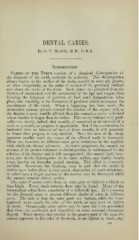Page 719 - My FlipBook
P. 719
DENTAL CARIES. ;
By G. V. BLACK, M. D., D. D. S.
Introduction.
Caries of the Teeth consists of a chemical disintegration of
the elements of the tooth, molecule by molecule. This disintegration
always begins on the surface of the tooth, usually in some pit, groove,
or other irregularity, at the point of contact of the proximal surfaces
and about the necks of the teeth. Such places are protected from the
friction of mastication and the movements of the lips and tongue, thus
favoring the lodgment of particles of food until fermentation takes
place, this resulting in the formation of products which decompose the
constituents of the tooth. When a beginning has been made, the
destructive process spreads toward the interior of the organ ; and, as
the dentine is more readily affected than the enamel, a cavity is formed
whose interior is larger than its orifice. This cavity enlarges very grad-
ually—so slowly, indeed, that usually, if examined at an interval of a
week or a month, no progress is appreciable. But if the examination be
instituted after an interval of two or three months, it will generally
be found that progress is very decided. Thus, the area of the decay
increases steadily until the crown of the affected tooth is destroyed.
There are, however, in different cases great variations in the rapidity
with which the disease advances. As caries progresses, the enamel, on
account of its greater resistance to disintegration, is undermined by the
solution of the dentine and is left unsupported ; the enamel itself, how-
ever, also slowly disintegrates on its inner surface, and finally breaks
away, leaving an irregular jagged opening. This effect is extremely
variable. Sometimes the breaking away is such that the cavity is
widely open before there is very much destruction of tooth-substance
in other cases a larger portion of the dentine may be destroyed, while
the enamel remains almost perfect.
The color of caries varies from an ashy gray or white to a bluish or
deep black. Every shade between these may be found. Many of the
intermediate colors have something of a yellowish hue. It is common
for the decayed mass to present different shades of color in different
parts. The rule is that the outer parts are darkest, while the inner
approach more nearly the color of the tooth, or may even be lighter
in shade. Occasionally other colors may be seen, but I am persuaded
that these are accidental and dependent on some unusual extraneous
deposit. Those decays that present in the greater part of the mass the
nearest approach to the color of the tooth, or are lighter in shade, rep-
729


